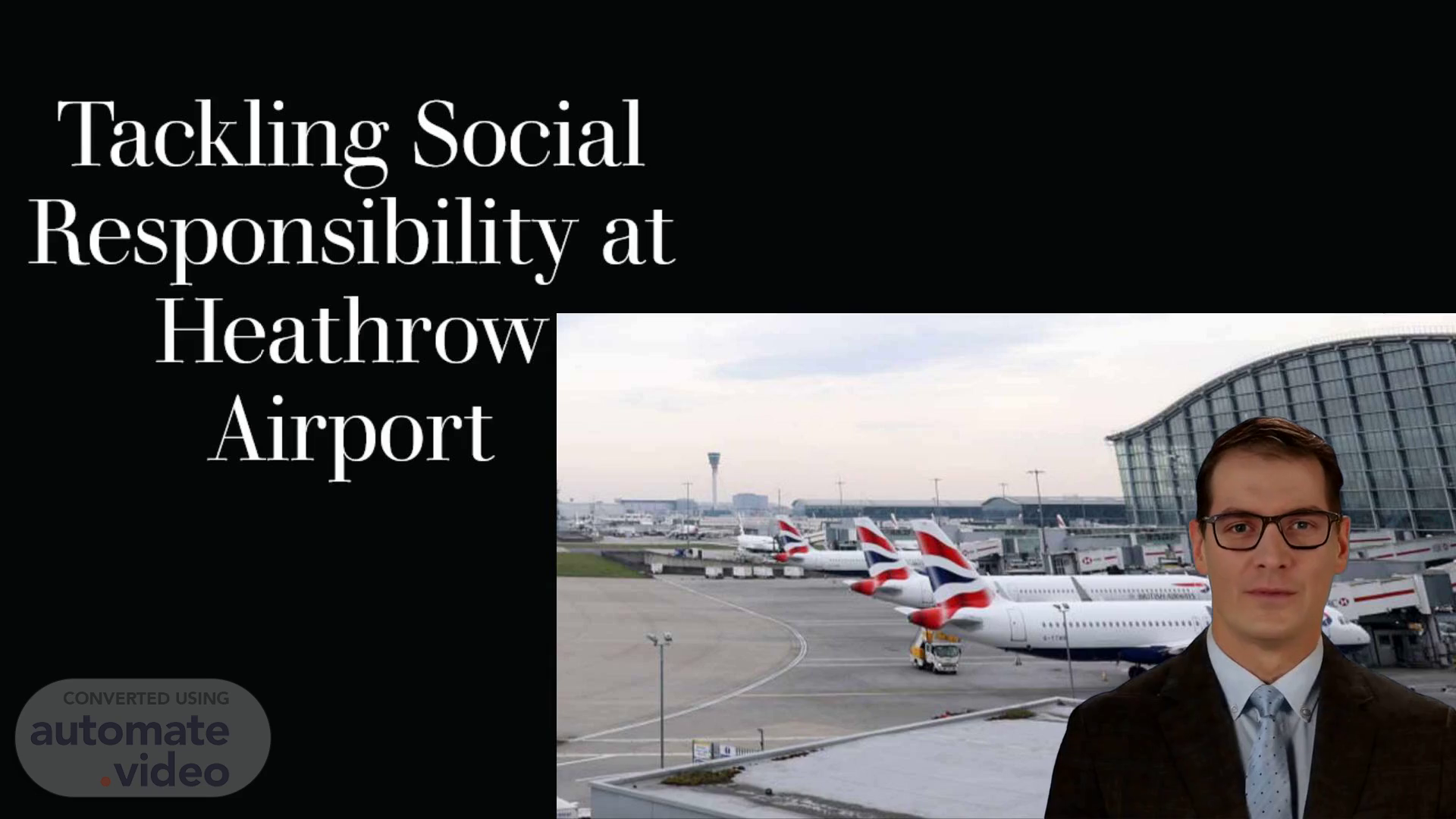Scene 1 (0s)
[Virtual Presenter] The presentation begins by welcoming viewers to the first slide of a training video titled "Other". The introduction explains that the discussion will revolve around various topics unrelated to spirituality, religion, politics, or sexuality. As professionals, it is crucial to stay informed and knowledgeable about diverse subjects. The presentation proceeds to explore the initial topic..
Scene 2 (28s)
[Audio] Heathrow Airport is the UK's busiest airport and a global hub in the aviation industry, facing pressure to reduce emissions and improve their community impact..
Scene 3 (40s)
[Audio] Heathrow Airport aligns with several key United Nations Sustainable Development Goals. One of these goals is SDG 13, which focuses on climate action. Heathrow aims to achieve zero-carbon operations and promote the use of sustainable aviation fuel. Another goal that Heathrow aligns with is SDG 11, which emphasizes sustainable cities and communities. The airport supports local communities through job creation, funding, and a commitment to providing 10000 apprenticeships by 2030. Furthermore, Heathrow also aligns with SDG 9, which highlights the importance of industry, innovation, and infrastructure. The airport invests in clean, modern infrastructure to support sustainable growth..
Scene 4 (1m 26s)
[Audio] Heathrow Airport is committed to evaluating its performance not only financially but also socially and environmentally. This commitment is evident from its fair employment practices, carbon neutrality targets, and efforts to balance conflicting interests such as economic growth versus noise pollution. By considering the interests of all stakeholders, including shareholders, employees, customers, and the environment, Heathrow demonstrates its dedication to sustainability and responsible business practices..
Scene 5 (2m 0s)
[Audio] Heathrow Airport's social responsibility actions are focused on reducing carbon emissions and improving the experience for employees and passengers. This includes cutting carbon emissions by 15% "in the air" and at least 45% "on the ground", aligning with SDG 13. Additionally, Heathrow is committed to improving quality of life for surrounding communities and working for their employees. They aim to adopt an "inclusive employer of choice for local diverse talent" and provide 10000 external jobs, aligning with SDG 8 and SDG 11. Furthermore, Heathrow is taking steps to reduce noise pollution, such as implementing "quieter nights, quieter flights". This approach allows for a comprehensive analysis of Heathrow's social and environmental impact against global sustainability standards..
Scene 6 (2m 51s)
[Audio] Heathrow Airport aims to achieve net-zero emissions by 2050 and has made significant progress towards this goal. Despite these efforts, the airport still faces challenges related to noise pollution, particularly affecting local residents who live near the airport. The airport operates over 1,300 flights daily, which can have a significant impact on the quality of life for those living nearby, including disruptions to sleep, learning, and overall well-being. On the other hand, the airport has had a positive impact on the local community, providing job opportunities and contributing to the local economy..
Scene 7 (3m 30s)
[Audio] Heathrow Airport's community impact has both positive and negative effects. The airport's daily operations create significant noise pollution, affecting the sleep, learning, and mental health of local residents. However, it also supports 76000 job opportunities, enhancing the local community's economy. To mitigate the negative impacts, Heathrow Airport implements initiatives such as the Quieter Homes Scheme, providing affected homes with financial assistance for sound insulation. Furthermore, the airport engages with local councils through the Community Engagement Board to ensure transparency and inclusivity in decision-making processes..
Scene 8 (4m 15s)
[Audio] Heathrow Airport maintains engagement with local councils such as the London Borough of Hillingdon, ensuring effective communication and collaboration. The airport also complies with UK Governance regulations on its emissions, adhering to the country's climate change act, which requires them to achieve net-zero emissions by 2050. In 2019, Heathrow emitted over 19 million tonnes of carbon dioxide. To improve its sustainability practices, the airport collaborates with non-governmental organizations like Sustainable Aviation and WWF UK. However, this has led to implications with Greenpeace, which opposed the expansion of a proposed third runway..
Scene 9 (5m 2s)
[Audio] Heathrow can take several steps to achieve better outcomes. Firstly, increasing transparency around their current offset schemes and partnering with verified carbon contributions at the point of ticketing would align with SDG 13's climate action. This would encourage passengers to participate in voluntary carbon contributions. Additionally, implementing transparent corporate social responsibility (CSR) reporting related to SDG 12's responsible consumption and production would involve adopting Global Reporting Initiative (GRI) reporting standards and sharing measurable social impact data. Furthermore, prioritizing inclusive and accessible infrastructure would link to SDG 10's reduced inequalities. This could be achieved by upgrading terminal designs for universal accessibility, including neurodiverse needs, and providing multilingual and assistive technologies..
Scene 10 (6m 1s)
[Audio] Heathrow Airport is amidst a changing journey, one that aligns with business growth and global responsibility. By embracing key ideas such as Climate Action, Sustainable communities, and Innovation and infrastructure, Heathrow is not just responding to criticism but leading change. Initiatives like 'Heathrow 2.0', transparent CSR reporting, inclusive design, and community investment demonstrate a deeper commitment to people, the planet, and profit, reflecting the Triple Bottom Line. With a strong focus on stakeholder engagement and measurable impact, Heathrow can be future-ready and respected globally..
Scene 11 (6m 43s)
[Audio] The references listed are a collection of sources used to support the claims made in the presentation. Official websites, academic articles, and news reports provide evidence-based information on topics such as sustainability, corporate social responsibility, and environmental impact. Citing these sources demonstrates transparency and accountability, building trust with the audience and ensuring accurate and reliable information..
Scene 12 (7m 10s)
[Audio] We have reached the conclusion of our presentation. I would like to express my sincere appreciation to each individual present for dedicating their time to listen to our discussion..
